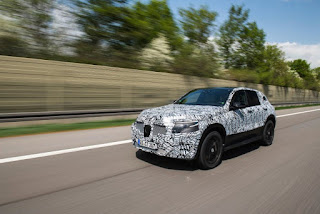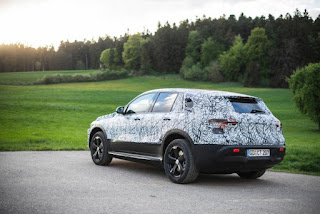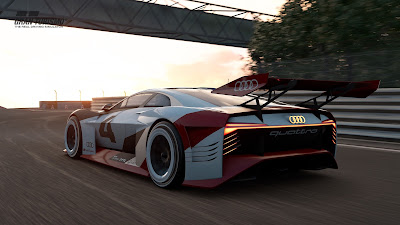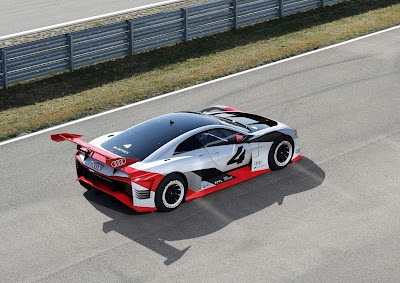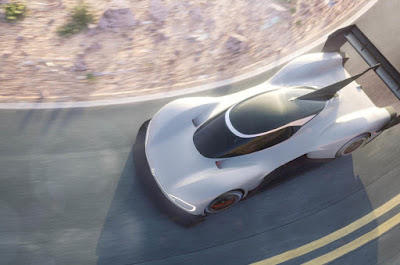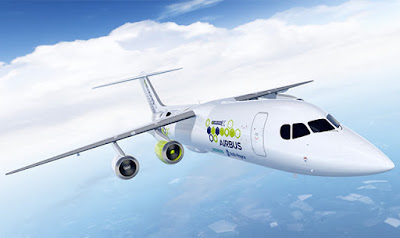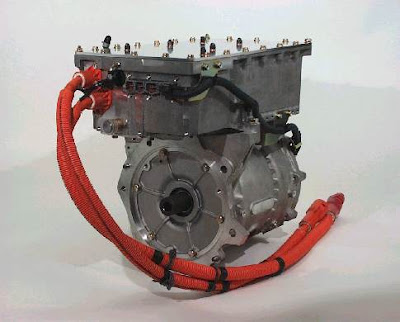- Totally digital: Digital testing covers all key areas of vehicle development: from simulation and validation of construction feasibility to crash performance, aerodynamics, ride & handling, NVH (noise/vibration/harshness), weight through to consumption and range.
- From computer screen to test bench and onto the road: Despite all the advantages of digital testing in terms of speed, data availability and efficiency – no vehicle goes into series production without extensive real-world testing. The focus here is on the durability of components such as drivetrains on the test bench and the functional testing of the entire vehicle under various climatic conditions on the road. In the case of the EQC, of course, special attention is paid to the electric powertrain and the battery. They too are tested and approved in accordance with Mercedes-Benz's extremely strict standards.
- Everything a question of proportion: A special role is also played by the acoustics of an electric vehicle, as, unlike in a combustion-engined vehicle, there is hardly a sound from the powertrain. This makes sounds such as the rolling of the tyres or wind noise more prominent. To meet these special requirements, we rely on our many years of experience in the area of NVH (Noise, Vibration, Harshness).
- One third/two thirds: With a ratio of 35% to 65% between digital testing and real-world testing, we combine the best of both worlds – in the interests of the customary high quality standards of Mercedes-Benz.
- Almost 200: That's how many prototypes and preproduction vehicles are built and tested for this purpose in our workshops.
- Several hundred: Before being released for production, the vehicle must be tested and validated by numerous individuals from many different development departments. A total of several hundred experts are involved in testing. From the specialist departments, which approve their components and modules, through to testing/endurance testing of the complete vehicle.
- Around four years: All in all, the EQC will have been in development for around four years.
- Three winters and three summers: The EQC will be subjected over three winters and three summers to extreme conditions from minus 35° to over plus 50° Celsius.
- A true cosmopolitan: Before coming to market in many countries around the world, the EQC will have undergone extensive testing in Germany, Finland, Sweden, Spain, Italy, Dubai, South Africa, the USA and China.
Audi e-tron Vision Gran Turismo: From the PlayStation to the race track
With the fully electric “Audi e-tron Vision Gran Turismo” concept car Audi is now turning electric mobility into a tangible experience in a unique way. Originally developed exclusively for virtual races on PlayStation 4, Audi is making the new race car reality in conjunction with Formula E. Starting with the race in Rome on Saturday, April 14, the Audi e-tron Vision Gran Turismo will be deployed as a race taxi.
“E-Mobility is rapidly gaining importance,” says Peter Mertens, Member of the Board of Management, Technical Development, AUDI AG. “That is why in 2017 Audi was the first German manufacturer to enter Formula E with a factory-backed commitment. In our development laboratory motorsport, we are continuously expanding our expertise in e-mobility and gathering valuable experience also in extremely demanding conditions. With the Audi e-tron Vision Gran Turismo race taxi we are turning electric mobility into a tangible experience for our customers and guests as part of the Formula E races – in the middle of the world’s metropolises.”
The customers and guests of the brand with the four rings will be able to experience Formula E’s city circuits as passengers in the Audi e-tron Vision Gran Turismo starting at the race in Rome (April 14). Employees at Audi’s pre-production center developed and produced this one-of-a-kind car within the space of just eleven months based on the example of the Audi e-tron Vision Gran Turismo from the “Gran Turismo” PlayStation game. The million-selling “Gran Turismo” game has long acquired cult status with gamers around the globe. Audi has been working together with Sony and Polyphony Digital – the creators of “Gran Turismo” – for nearly 20 years. Audi designers created the Audi e-tron Vision Gran Turismo for the “Vision Gran Turismo” competition that was launched on the market on the occasion of the popular game’s 15th anniversary. Numerous automobile manufacturers developed virtual race cars for the contest.
Many of these concept cars were subsequently built as full-scale models as well and presented at trade shows. The Audi e-tron Vision Gran Turismo, however, is the first concept car of this range to be deployed to real-world race tracks as a fully functional vehicle. “This is what we are particularly proud of,” says Audi’s chief designer Marc Lichte. “Although the design of a virtual vehicle allows much greater freedom and the creation of concepts which are only hard to implement in reality, we did not want to put a purely fictitious concept on wheels. Our aim was a fully functional car. The Audi e-tron Vision Gran Turismo shows that electric mobility at Audi is very emotive. This car incorporates numerous elements of our new design language such as the inverted single frame in the vehicle’s color that will be typical for our new e-tron models.”
Audi has deliberately taken up design elements and the color of the legendary Audi 90 quattro IMSA GTO with which the company in 1989 thrilled motorsport fans in the North American IMSA-GTO racing series with drivers like Hans-Joachim Stuck, Walter Röhrl, Hurley Haywood and Scott Goodyear. Featuring a combination of systematic lightweight design and quattro drive paired with a powerful five-cylinder turbo engine, the car was far ahead of its time back then.
The Audi e-tron Vision Gran Turismo has permanent all-wheel drive as well, the fully electric e-tron quattro all-wheel drive with variable power distribution. Three electric motors, each with output of 200 kW, propel the concept car. Two electric motors drive the rear axle and the third one the front axle, using individual components from the future Audi e-tron. System output is 600 kW (815 hp). With a curb weight of 1,450 kilograms the electric race car has a power to weight ratio of 1.78 kilograms per horsepower with ideal 50:50 percent weight distribution between the front and the rear axle. The Audi e-tron Vision Gran Turismo accelerates from 0 to 100 km/h in less than 2.5 seconds.
The futuristic race taxi will be deployed at all European Formula E races and numerous other events in 2018. At the wheel will be former DTM driver Rahel Frey from Switzerland or Le Mans winner Dindo Capello from Italy.
Electric planes to race from London to Darwin in 2019
Electric aircraft will race from London to Darwin next year to mark the centenary of the Great Air Race.
The race and a series of other events in the Top End will celebrate 100 years since Captain Ross Smith, Lieutenant Keith Smith and Sergeants Wally Shiers and Jim Bennett won the first event.
"The 1919 Great Air Race captured the imagination of people across the globe," Northern Territory Chief Minister Michael Gunner said on Saturday.
"Under the command of Captain Ross Smith, the journey has been described as the flight that changed the world and paved the way for national and international air travel."
The 2019 event, to be known as the Centenary E-Race, will start in London late next year and stop over in at least 15 countries before making its way to Darwin.
It is hoped that world-leading technology companies including Tesla, NASA, Airbus, Virgin and Boeing will enter in celebration of a century of aviation innovation and achievement by engineers, designers and aircraft constructors.
The advantages of electric aircraft are huge, however, achieving long distance flight in an electric aircraft is still the greatest challenge. There are currently three approaches to tackling this problem, battery electric, hydrogen fuel-cell electric, and hybrid combustion-engine electric.
Captain Smith and his colleagues flew a Vickers Vimy Biplane more than 18,000km in 28 days in 1919, with the race acting as a catalyst for international travel and improved communications.
John Storey, an expert in battery and solar technology, said the 2019 race would fast-track renewable flight technology by years and contribute to improving the e-aviation industry.
"The event is technically feasible, however, completing the route in an electric aircraft is by no means a foregone conclusion," Professor Storey said.
"That makes 2019 the right time to stage it. In 2009 it would have been impossible, in 2029 it will be routine."
The program of celebrations in Darwin will include an air show, centenary ball, commemorative ceremonies and education programs for schools.
The Ross Smith Memorial at Fannie Bay will also undergo significant conservation work.
Source: Great Air Race
Volkswagen reveal ID-R all-electric prototype Pikes Peak racer
Volkswagen has named its latest motorsport project the I.D. R Pikes Peak. This all-electric prototype racing car will compete in the Pikes Peak International Hill Climb on 24 June in Colorado.
The four-wheel-drive racing car points to the sporting potential of the I.D. family of all-electric vehicles and is also the first step towards a closer relationship between Volkswagen R and Volkswagen Motorsport.
The Volkswagen brand plans to offer more than 20 fully-electric cars by 2025. Manufacture of the first production model of the I.D. family is scheduled to start at the end of 2019 in Zwickau, Germany.
"We want to be at the forefront of electro-mobility with Volkswagen and the I.D. family. Competing in the most famous hillclimb in the world with the I.D. R Pikes Peak is a valuable test for the general development of electric cars."
—Dr. Frank Welsch, Volkswagen Member of the Board of Management with responsibility for Development
The international Pikes Peak Hill Climb, also known as the “Race to the Clouds”, has been held since 1916 near Colorado Springs in the Rocky Mountains. The 12.4-mile route starts at just above 9,000 feet and climbs to the summit at 14,115 feet above sea level.
Volkswagen last entered the Pikes Peak hillclimb in 1987 with a spectacular dual-engine Golf, which generated 652 horsepower. However, Volkswagen did not win.
"It is about time we settled the score. The I.D. R Pikes Peak represents an extremely exciting challenge for us, to show what is possible in motorsport with an electric drivetrain. The entire team behind our driver Romain Dumas is highly motivated to set a new record for electric cars."
—Volkswagen Motorsport Director, Sven Smeets
The record in the electric prototype class currently stands at 8:57.118 minutes, set in 2016 by New Zealand’s Rhys Millen.
World Rallycross Championship all-electric in 2020
Volkswagen's push for the development of an all-electric rallycross supercar were revealed by EV News in March 2016 with plans for electric cars to be introduced into the World RX structure announced in August of last year, but a source has now indicated that electric cars will take the place of conventional internal combustion engine Supercars in the headline category after next year.
“Electric cars will be the world championship. They absolutely, categorically will be the world championship,” the source told Autosport.
“Fifteen cars are required to begin in 2020. Nine different manufacturers have been engaged in the discussions and negotiations so far, but the ability to buy the required components and build a car has to be open to privateer teams if they want to go that way too.”
It’s understood that the new electric cars will be based on a common carbon monocoque tub and safety structure that will be supplied as part of a chassis kit, expected to also include suspension and braking systems.
The FIA is expected to issue an invite to tender for the chassis kit in the coming weeks, with an additional invite to tender for batteries.
It’s believed that motors won’t be from a single supplier and neither will the composite body shells that will sit on top of the carbon chassis’, allowing for different models of cars to be used.
Competitive development of quad-motor all-wheel-drive torque vectoring electric powertrains could provide the missing link between electric motorsport and road-car technology.
Volkswagen have made clear that its electric Pikes Peak programme is designed as a learning project towards a future factory electric RX entry.
Magna To Unveil etelligent Drive Systems @ CES 2018
Magna’s etelligentDrive systems will be on display at CES 2018. The company’s e1 concept vehicle will be used to demonstrate different electric-drive (e-drive) concepts and systems, as well as demonstrate Magna’s vehicle integration capabilities. The e1 system consists of one highly integrated e-drive system on the front axle and one on the rear axle with two electric motors (e-motors).
Magna says the demo car achieves superior longitudinal and lateral dynamics combined with excellent vehicle stability for more safety. Each e-drive system in the demo vehicle uses 3x 140-kilowatt AC induction motors, adding up to an overall performance of 420-kilowatt peak.
The Tesla Model S based e1 concept vehicle demonstrates improved stability and handling with electronic torque vectoring (eTV). The powertrain features an integrated eDrive 140 kW peak AC induction on the front axle while the rear axle has an integrated eDrive with 2 x 140 kW AC induction motors connected to a summation gearbox and axle lock clutch operated by the eTV control system to provide torque vectoring.
Magna is responsible for providing the e-motor, electronic control module/inverter and the transmission for the Ford Focus BEV and Magna has supplied Volvo with the electrified rear axle drive system (eRAD) featured on the Volvo V60 and S60 plug-in hybrid models. Magna’s eRAD system offers multiple hybrid driving modes while also adding electric all-wheel-drive capability.
More recently, the company announced a joint venture partnership with Hasco in China to produce a high volume e-drive system for a German automaker.
Airbus, Rolls-Royce, and Siemens team up for electric aircraft
Airbus, Rolls-Royce, and Siemens have formed a partnership which aims at developing a near-term flight demonstrator which will be a significant step forward in hybrid-electric propulsion for commercial aircraft.
The three companies together announced the groundbreaking collaboration, bringing together some of the world’s foremost experts in electrical and propulsion technologies, at the Royal Aeronautical Society in London.
The E-Fan X hybrid-electric technology demonstrator is anticipated to fly in 2020 following a comprehensive ground test campaign, provisionally on a BAe 146 flying testbed, with one of the aircraft’s four gas turbine engines replaced by a two megawatt electric motor. Provisions will be made to replace a second gas turbine with an electric motor once system maturity has been proven.
“The E-Fan X is an important next step in our goal of making electric flight a reality in the foreseeable future. The lessons we learned from a long history of electric flight demonstrators, starting with the Cri-Cri, including the e-Genius, E-Star, and culminating most recently with the E-Fan 1.2, as well as the fruits of the E-Aircraft Systems House collaboration with Siemens, will pave the way to a hybrid single-aisle commercial aircraft that is safe, efficient, and cost-effective,” said Paul Eremenko. “We see hybrid-electric propulsion as a compelling technology for the future of aviation.”
The E-Fan X demonstrator will explore the challenges of high-power propulsion systems, such as thermal effects, electric thrust management, altitude and dynamic effects on electric systems and electromagnetic compatibility issues. The objective is to push and mature the technology, performance, safety and reliability enabling quick progress on the hybrid electric technology. The programme also aims at establishing the requirements for future certification of electrically powered aircraft while training a new generation of designers and engineers to bring hybrid-electric commercial aircraft one step closer to reality.
Paul Stein, Rolls-Royce, Chief Technology Officer, said: “The E-Fan X enables us to build on our wealth of electrical expertise to revolutionise flight and welcome in the third generation of aviation. This is an exciting time for us as this technological advancement will result in Rolls-Royce creating the world’s most powerful flying generator.
“Siemens has been driving innovation in core technology fields at full speed,” said Roland Busch, Chief Technology Officer of Siemens. “In April 2016 we opened a new chapter in electric-mobility with the collaboration with Airbus. Building up electric propulsion for aircraft, we are creating new perspectives for our company and also for our customers and society. With the E-Fan X partnership, we now take the next step to demonstrate the technology in the air.”
Among the top challenges for today’s aviation sector is to move towards a means of transport with improved environmental performance, that is more efficient and less reliant on fossil fuels. The partners are committed to meeting the EU technical environmental goals of the European Commission’s Flightpath 2050 Vision for Aviation (reduction of CO2 by 60%, reduction of NOx by 90% and noise reduction by 75%). These cannot be achieved with the technologies existing today. Therefore, Airbus, Rolls-Royce and Siemens are investing in and focusing research work in different technology areas including electrification. Electric and hybrid-electric propulsion are seen today as among the most promising technologies for addressing these challenges.
Renault Samsung unveil new SM3 Z.E with 36 kWh battery
Renault Samsung Motors have unveiled the new SM3 Z.E. at the Daegu International Future Auto Expo in South Korea. Determined to upgrade its electric vehicle range to meet customer demand, and buoyed by the EV expertise it has gained over the past eight years, Groupe Renault is continuing to renew its line-up, the latest example being the new version of the SM3 Z.E. which first appeared in 2013.
The autonomy of the Renault Samsung Motors SM3 Z.E. – the market’s only three-box saloon – has been increased by 57 percent to 213 kilometres based on the Korean type approval cycle.
Battery power has been upped to 36kWh with no increase in weight and, with the average daily trip in South Korea standing at 40 kilometres in 2016 according to a Korean Transportation Safety Authority (KOTSA) report, the new SM3 Z.E. is capable of running for approximately five days on a single charge.
This increase in autonomy and the model’s spacious cabin will permit the SM3 Z.E. to address the strong demand expressed not only by retail customers, but also by state-run fleets and taxi operators. Indeed, 1,200 cars were purchased by South Korea’s Ministry of Health and Welfare last April, while the model is also popular as an EV taxi in Seoul, Daegu and Jeju Island.
Honda to halve electric cars’ charging time to 15 minutes
Honda Motor plans to release in 2022 a selection of fully electric cars that can run 240km on a single 15-minute charge. Most electric vehicles now available take at least twice that long to reach an 80% charge even using a high-speed charger.
Key to this plan is developing a new type of high-capacity battery that can handle the ultra-quick charging. The carmaker sources batteries for its electric-gas hybrid vehicles from Panasonic and others, but plans to create the new batteries in collaboration with a partner to be chosen later. A lighter vehicle body and more efficient power control system will ensure the new cars can go farther on a single charge.
Before then, Honda plans to release mass-market electric vehicles in Europe in 2019 and in Japan the following year.
Fast chargers in Japan now provide a maximum output of 150kW, but industry plans call for raising that to 350kW starting in 2020. Europe is expected to have a network of several thousand 350kW charging stations by that year. Honda's next-generation electric vehicles will take advantage of this faster charging infrastructure.
Nissan Motor's new 2018 Leaf will also offer quicker charging times than the current model and range 30% longer -- more than 500km on a single charge. The automaker has a head start on Japanese rivals Honda and Toyota Motor in mass-market electric vehicles.
There were 470,000 electric vehicles on the world's roads in 2016, according to Tokyo-based research firm Fuji Keizai, making up 0.5% of the total. That share is expected to climb to only 4.6% by 2035. By offering faster charging and longer range, Honda hopes to give its electric cars an edge with everyday drivers.
Hitachi to make electric-vehicle motors in China
Hitachi will turn out electrified-automobile motors in China as soon as fiscal 2020, aiming to capitalise on a government initiative to boost production of environmentally friendly vehicles.
Hitachi Automotive Electric Motor Systems, a joint venture of Hitachi Automotive Systems and Honda Motor, established a unit in Guangdong Province dedicated to the development and production of motors for electrified vehicles, including hybrids, according to Monday's announcement.
Outlays for the production facilities, which will be built on an 88,000-sq.-meter plot, and capacity have not been disclosed. Mass production may kick off in the fiscal year starting April 2020. Hitachi also operates similar sites in Japan and the U.S.
Under the new initiative, automakers will soon be required to make and sell a minimum number of so-called new-energy vehicles based their overall output. These vehicles must account for 10% of production in 2019 and 12% in 2020, with adjustments made for such factors as models that run for longer distances.
Global auto manufacturers have indicated plans to upgrade their new-energy vehicle businesses in China.
Hitachi Automotive Systems, which also makes lithium-ion battery systems for autos, seeks to increase sales 260% in fiscal 2020 from the fiscal 2016 level.


